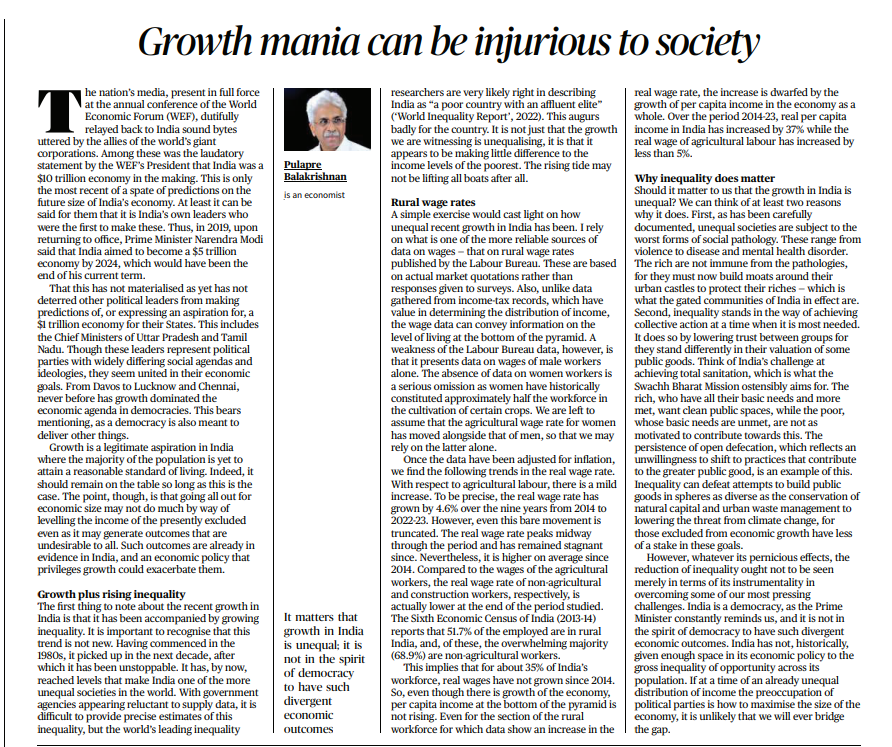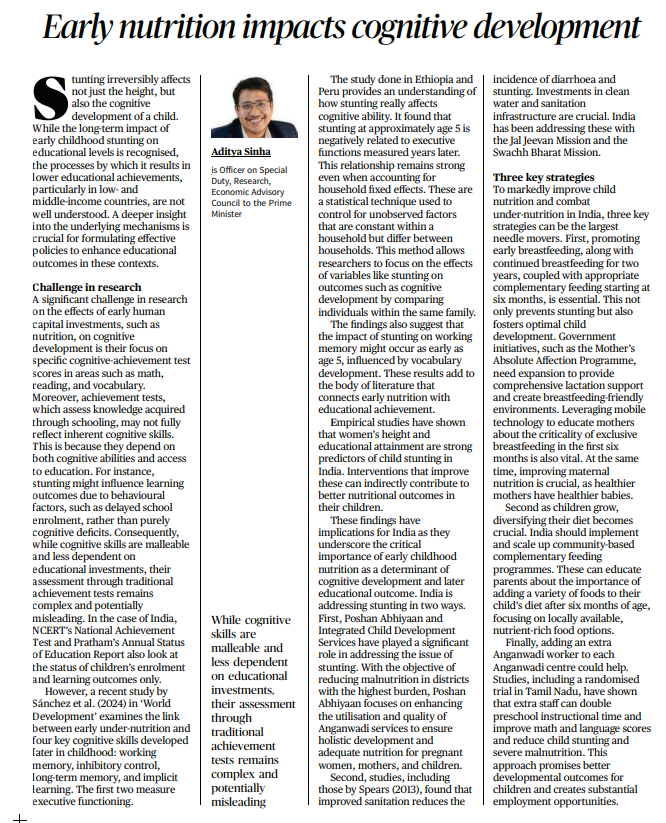Introduction
- The media extensively covered the annual World Economic Forum (WEF) conference, where the President of WEF praised India as a potential $10 trillion economy.
- This mirrors earlier projections by Indian leaders, including Prime Minister Narendra Modi’s aim for a $5 trillion economy by 2024.
Political Leaders’ Economic Aspirations
- Various political leaders, despite differing ideologies, share aspirations for their states to achieve a $1 trillion economy.
- The focus on economic growth in democracies, from Davos to regional capitals, raises questions about the multifaceted role of democracies in delivering not just economic progress but other societal benefits.
Growth as a Legitimate Aspiration
- Acknowledging the legitimate aspiration for growth in a country where a significant portion of the population is yet to attain a reasonable standard of living.
- However, the concern arises that an exclusive pursuit of economic size may not address income inequality and might lead to undesirable outcomes.
Growth and Rising Inequality
- The recent economic growth in India is accompanied by growing inequality, a trend that has persisted since the 1980s, making India one of the more unequal societies globally.
- The growth seems unequalizing, with little impact on the income levels of the poorest.
Rural Wage Rates
- Examining rural wage rates, a reliable indicator of living standards, reveals a mild increase in real wage rates for agricultural labor over the years.
- However, this growth is truncated, and for non-agricultural workers, the real wage rates are lower at the end of the studied period.
Per Capita Income Disparities
- Considering the Sixth Economic Census, it is noted that for about 35% of India’s workforce, real wages have not grown since 2014.
- The overall per capita income growth is significantly higher than the increase in real wages, especially for agricultural labor.
Impact of Inequality
- Unequal growth is concerning for two reasons: firstly, unequal societies are prone to social pathologies such as violence and mental health disorders.
- Secondly, inequality hampers collective action by lowering trust between groups, hindering the pursuit of common goals like public sanitation.
Democracy and Economic Disparities
- Highlighting the historical neglect in Indian economic policy regarding the gross inequality of opportunity across the population.
- The preoccupation with maximizing the size of the economy, especially amidst existing income inequality, challenges the spirit of democracy and hinders efforts to bridge economic gaps.
Conclusion
While economic growth is a legitimate aspiration for India, the current trajectory raises concerns about its impact on rising inequality.
The reduction of inequality is not only instrumental in addressing societal challenges but is also crucial for maintaining the democratic spirit in a diverse nation like India.
Introduction
- In India, a silent battle for public health is underway, focusing on preventing diseases through improved sanitation and vaccines.
- However, this preventive approach often takes a backseat to immediate, tangible achievements favored by political leaders.
Immediate Response vs. Sustainable Prevention
- Political leaders prioritize immediate responses, like setting up relief camps during disease outbreaks, sidelining long-term strategies.
- The case of dengue exemplifies the need for a balanced approach, emphasizing both immediate relief and sustainable prevention through research and development.
Separating Health Care from Political Processes
- Drawing parallels with India’s judicial setup and space program, the article suggests separating health care from political processes.
- Public health decisions should be driven by scientific evidence and long-term goals, avoiding short-term political interests to ensure effective policies.
Neglect of Preventive Health Measures
- Quoting civil servant Joseph Bhore, the article emphasizes the economic and human cost of neglecting preventive health measures.
- Despite initiatives like POSHAN Abhiyan Scheme, there is a significant gap between policy targets and the actual prevalence of issues like malnutrition, highlighting shortcomings in public health efforts.
Influence of the Pharmaceutical Industry
- The pharmaceutical industry’s profit-driven nature often sidelines public health efforts, contributing to significant disparities in disease prevalence.
- Socio-economic factors, such as poverty and sanitation issues, are linked to the high incidence of diseases like tuberculosis in India compared to other countries.
Gaps in Behavioral Change and Education
- The editorial identifies gaps in behavioral change and education, emphasizing the absence of specialized courses like public health engineering in India’s educational institutions.
- Public health requires a multidisciplinary approach, involving expertise from fields such as environmental science, sociology, urban planning, and economics.
Need for Autonomy in Public Health Management
- To address the shortcomings, the article advocates for a degree of autonomy in public health management.
- It suggests adopting a separation of powers approach, similar to the management of space and atomic energy departments, to ensure policymaking driven by scientific evidence and long-term objectives.
Placing Health Ministries under Elected Officials
- The proposed solution involves placing Health Ministries directly under the leadership of elected officials, ensuring a degree of autonomy while aligning health policies with immediate public needs.
- This approach aims to strike a balance between expert-driven decisions and public aspirations.
Conclusion
While democracy itself is not harmful to public health, the management of public health within democratic systems often leads to significant shortcomings.
The editorial concludes that a separation of health-care decision-making from short-term political goals is crucial for developing sustainable health strategies that address both immediate and future health needs.
Introduction:
- Stunting’s Impact on Height and Cognitive Development.
- Lack of Understanding Regarding Educational Consequences in Low- and Middle-Income Countries.
Research Challenge:
- Focus on Cognitive Achievement Test Scores.
- Limitations of Achievement Tests in Reflecting Inherent Cognitive Skills.
- Behavioral Factors vs. Cognitive Deficits in Learning Outcomes.
Recent Study (Sánchez et al., 2024):
- Examining Link Between Early Under-Nutrition and Cognitive Skills.
- Four Key Cognitive Skills: Working Memory, Inhibitory Control, Long-Term Memory, Implicit Learning.
- Strong Negative Relationship Between Stunting at Age 5 and Executive Functions.
- Household Fixed Effects as a Control Mechanism.
Implications for India:
- Connection Between Women’s Height, Educational Attainment, and Child Stunting.
- Indirect Contribution of Women’s Improvement to Child Nutrition.
- Importance of Early Childhood Nutrition for Cognitive Development and Educational Outcomes.
India’s Efforts in Addressing Stunting:
- Poshan Abhiyaan and Integrated Child Development Services.
- Focus on Malnutrition Reduction and Holistic Development.
- Role of Jal Jeevan Mission and Swachh Bharat Mission in Sanitation.
Key Strategies for India:
- Promoting Early Breastfeeding and Continued Breastfeeding.
- Importance of Complementary Feeding and Diversifying Diet.
- Adding Extra Anganwadi Workers for Improved Preschool Instructional Time.
Conclusion:
- Need for Comprehensive Strategies in Child Nutrition.
- Addressing Stunting’s Impact on Cognitive Development through Early Interventions.
- Importance of Maternal Health and Clean Water/Sanitation Initiatives.
This editorial summary highlights the critical link between early childhood stunting, cognitive development, and educational outcomes, with a focus on recent research findings and their implications for India. The note concludes by emphasizing key strategies to improve child nutrition and address the challenges associated with stunting.




